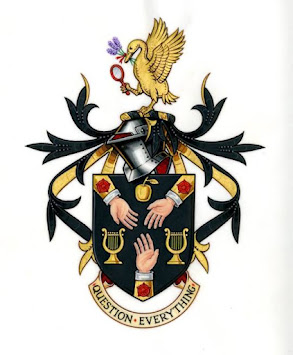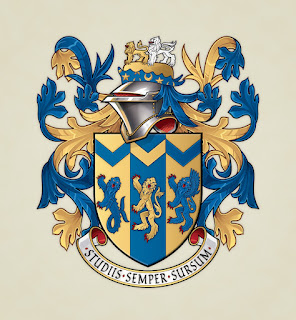A Starry, Starry Knight
A Starry, Starry Knight
By Benjamin Nossiter
It was a dark night with battle raging in the Middle East. A conflict of religious beliefs and ambition. The first crusade. There were decorated and quartered shields “of diverse cognisances” as Turold says, or as Anna Comnena described them, “not round but long, broad at the top and tapering to a point”. Swords versus sabres, crossbow versus composite bow. The hauberks, helmets, plate armour and those colourful shields witness to the brutal reality of hand to hand combat. In the darkness the patterns on the shields could scarcely be made out. An angel is said to have intervened, throwing a bright white star onto Aubrey de Vere’s standard.
If these decorated shields and standards are what we picture when thinking about heraldry, we are a little too early. Although symbols were present and held meaning, the idea of heraldry, or correctly armory, as an identifier of an individual and his descendants comes a generation or so later. The origins of heraldry are normally attributed to King Henry I with arms granted to Geoffrey Plantagenet.
At the time of the third crusade, on the seals of Richard Cœur de Lion, the king is identified not by those famous lions of England but by a crescent moon and either a star or the sun. The ‘star and crescent’ as a combined symbol had been associated with Byzantium since classical antiquity. Kings John and Henry III also used the star and crescent moon badge and it formed the coat of arms of William de Longchamp, Lord Chancellor, who governed England while King Richard was on crusade. The same design has been borne by the City of Portsmouth for more than 800 years.
The significance of the combination of star and crescent would ultimately reach beyond Byzantium, the crusaders and the City of Portsmouth. By the 15th century it had gained prominence as a symbol of the Ottoman Empire and was later adopted as an emblem of Islam.
Arms of William de Longchamp, Lord Chancellor (d.1197)
Arms of the City of Portsmouth: A Crescent ensigned by an Estoile of eight points
Now let me get this of my chest:
The crest crests a coat of arms,
A coat of arms is not a crest!
Neither is the shield. The components of a heraldic achievement; shield, crest, helm, wreath, mantle, motto, supporters, etc. retain historical connections to their military and tournament origins. Tournaments developed the form of heraldic art, with crests worn by knights as decorative sculptures on top of their great jousting helmets. Brightly coloured banners and surcoats and romantic acts of chivalry have led many to imagine that heraldry is exclusive to knights and the nobility. This common prejudice overlooks its broader use, as heraldry was widely adopted across all levels of society, including by peasants. Over time, restrictions on heraldic entitlement have eased, and today, heraldry is more accessible, reflecting an increasingly egalitarian approach.
After the 16th century, when tournaments fell out of fashion, the crests, helm designs and mantles continued to feature in heraldic artworks as ‘paper heraldry’ but their military origins were not forgotten. Ecclesiastical arms deliberately exclude the helm. Some would deny women the use of helm or crest, claiming that heraldry belongs to an age of chivalry; that women never rode in the lists nor wielded an axe on a medieval battlefield. I must confess, neither have I. Heraldry is “a living beast”, slowly evolving with us and it is a mistake to look back too fondly at the ways of our worm-ridden ancestors as though we stand at the end of some glorious age.
“It was a Dark and Stormy Knight”, drawing by A. S. Paterson from “Knight After Knight”, Auckland, 1970
Lions have long been popular, not as zoological specimens drawn from nature but as symbolic representations of aspirational character traits. In contrast, stars are comparatively rare in European heraldry during the medieval period. In Scotland, the armigers of Clan Murray and Clan Douglas used arms with stars as early as the 12th or 13th century. In England the star in the coat of arms of the De Vere family, Earls of Oxford, is found in armorials of the 13th century. This de Vere star, in another battle and a moment of confusion, arguably changed the course of English history.
Arms of Hugh de Vere, 4th Earl of Oxford (d. 1263) as depicted by Matthew Paris ca. 1250
Stars ‘of five points’ are found in early English and Scottish heraldry. In German heraldry stars of six points were not uncommon. Some, perhaps wishing to outshine everyone else, added so many rays that the star is not dissimilar to the sun. What might these early stars represent? Are they emblematic of an inner, spiritual light, the rowel of a knight’s spurs, a natural star of the heavens or simply an eye catching shape? Or might they, much like David Garrick’s crest, represent a star of the stage? Such distinctions were manifested in specific terminology and star designs which, due to their similarities and inconsistent interpretation across the British Isles and abroad, have caused considerable confusion.
Doubt thou the stars are fire,
Doubt that the sun doth move,
Doubt truth to be a liar,
But never doubt I love.
Hamlet, Act 2, Scene 2. Polonius














It bring us back to the crusades which is almost the graal of heraldry, are you a true noble if your ancestors were not in Jerusalem 😅
ReplyDelete